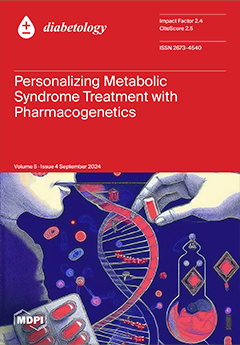Postprandial hyperglycemia was shown to be an independent risk factor for microvascular and macrovascular complications in type 2 diabetes mellitus (T2D). We aimed to investigate the glucose, insulin, and subjective appetite at 0, 15, 30, 45, 60, 90, 120, 150, and 180 min
[...] Read more.
Postprandial hyperglycemia was shown to be an independent risk factor for microvascular and macrovascular complications in type 2 diabetes mellitus (T2D). We aimed to investigate the glucose, insulin, and subjective appetite at 0, 15, 30, 45, 60, 90, 120, 150, and 180 min of three treatments: diabetes-specific formula (DSF), noodle soup, and glutinous rice. This was a randomized, crossover study with a one-week interval between treatments. Sixty-four T2D adults with oral glucose-lowering medication and HbA1c between 7% and <10% were randomized. The glucose positive area under the curve from 0 to 180 min (pAUC) was significantly lower with DSF than with glutinous rice (LSM ± SE: DSF 354 ± 32 vs. glutinous rice 451 ± 32 mmol.min/L,
p = 0.033). The insulin pAUC was significantly lower with DSF (median [IQR]: 2733 [1542, 4204]) compared to glutinous rice (3359 [2193, 4744] µIU.min/mL),
p = 0.042). The insulinogenic index at 30 min was significantly higher in DSF (median [IQR], 8.1 [4.2, 19.7]) compared to glutinous rice (5.4 [2.7, 11.7],
p < 0.001). No significant differences were found in subjective appetite between the three treatments (all,
p ≥ 0.827). There were also no significant differences in hunger, fullness, desire to eat, and prospective consumption ratings between DSF and the other two breakfasts (all
p ≥ 0.181). Noodle soup led to the shortest time for hunger to return to baseline (165 min), 21 min earlier than DSF (186 min) and 32 min earlier than glutinous rice (197 min). DSF significantly reduced postprandial glucose and insulin responses compared with glutinous rice and had a higher satiating value than noodle soup in T2D adults. Replacing common Asian breakfasts with DSF may improve glycemia and hunger control.
Full article





